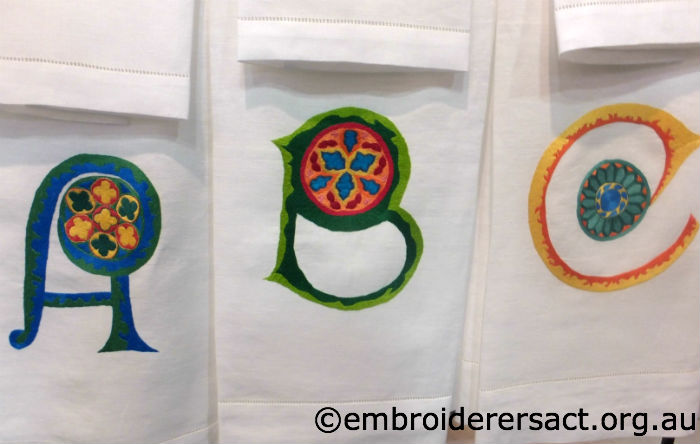Perugia & Punto Perugino
Perugia is a beautiful medieval city in Umbria. It has a famous chocolate festival and wonderful textiles – what’s not to love?! As the name suggests Punto Perugino is associated with Perugia and the history of this embroidery technique is interwoven with that of the city’s literature, art and agriculture.
It’s a counted satin stitch technique on even weave fabric. Designs can also use cutwork and eyelets, bullion knots and curl stitch. The patterns are geometric and larger scale designs can also have strong figurative elements such as birds, animals, flowers and mythological creatures. These come from the medieval art and literature of Perugia.
Most of the research on Punto Perugino has been done by the Punti d’Arte Workshop in the town of Pieve near Perugia. They had a stand at Italia Invita with wonderful examples of this embroidery style. As they’re in the process of writing a book they couldn’t allow photos but I did buy a couple of items and I can share these with you. Here’s a tiny needlebook with a simple but very characteristic motif in satin stitch:

and a closer look:

Now for a more elaborate square:

And a closer look at a corner:

When I showed this piece to Guild members Meryl Fellows immediately spotted that the needlelace inserts are in fact the sunflower motif also used in Hardanger:

Meryl is an amazingly talented stitcher across a whole range of embroidery styles and she’s been showing me how to do this motif.
As you can see from the square above the most characteristic pieces of this style of embroidery are done in a golden yellow coloured thread and materials. This dyeing tradition comes from the saffron growing industry around Perugia and the fibres are dyed using very old local recipes. Other traditional colours used are rust, red, light brown and blue. Here’s some dyed thread I bought from the Punti d’Arte stand at Italia Invita:

Until recently there wasn’t much detail known about the history of Perugino but then a conversation between researchers from the Punti d’Arte Workshop and a nun at the local convent of the Poor Clares led to the discovery of some historic pieces preserved by the nuns. These take the provenance of the technique back to at least the end of the 18th century.
In the Australian context I’d read some references to Punto Perugino having its origins in Sardinia but when I researched all the Italian material I couldn’t find any reference to Sardinia. This left me puzzled so I asked the representatives from the Punti d’Arte Workshop whether there was any connection between Perugino and Sardinia. They confirmed that there is no connection between this technique and Sardinia.
At the moment there’s only one book available on Perugino and this is Silvana Fontanelli’s Il Piacere del Ricamo. It’s in Italian but the diagrams and instructions are excellent and easy to follow.
Punto Deruta
The town of Deruta in Umbria is famous for its ceramics and two lovely styles of embroidery developed there. These have medieval roots in the 13th century but like so many other Italian textiles faded and were then revitalised in the early 20th century as part of a more general arts and crafts movement.
The Deruta embroidery schools were started by nuns and two local sisters Aurelia and Luce Corcioni and their promotional efforts saw the embroideries exported worldwide. The Accademia Punto Deruta had a very popular stand at Italia Invita that showcased both embroidery techniques:

The first style features the coloured Deruta embroideries stitched on a medium weight Umbrian linen with embroidery floss. These are typically homewares and the designs are based on a particular ceramic and are usually presented together with the ceramic. Here’s a wonderful example from Italia Invita:

and a closer look:

Another characteristic of this Deruta style is the use of tassels that include a ceramic bead called a fuserole. You can see some colourful examples of these beads here on the Italian Needlework site.
The other type of Deruta embroidery is very different. It’s called Punto Deruta and is a drawn thread technique usually done on Buratto – a fine open weave netting. Here are some examples from the Accademia Punto Deruta stand:

This swirly tree of life really caught my eye:


Punto Assisi
Assisi work is one of the best known Italian embroidery techniques. The Accademia Punto Assisi had a large stand at Italia Invita packed with exquisite work both in the traditional Assisi counted technique and in the Punto Madama or Caterina di Medici technique – more about the latter in the next Italia Invita post.
Here’s some eye candy for you:



You can get more information on the Associazione Punto Assisi here – they have an extensive classes program.
Irish Crochet Lace
Tuoro di Trasimeno is a picturesque town about 25 km NW of Perugia on the northern shore of Lake Trasimeno. It has an embroidery and lace school run by the Associazione Culturale Femminile P.Es.Co who were also at Italia Invita.
The lace style that has flourished in this area is Irish Crochet Lace. It was introduced here in the early 20th century by Elena Guglielmi, the daughter of the Marchese Giacinto. She thought it was a particularly appropriate technique for the daughters of the local fishermen who were already highly skilled at weaving fishing nets.
The school she started was very active until the 1930s when it closed. There was then a break until the 1960s and 70s when the embroidery and lace traditions were revived. Here are some photos of the Associazione Culturale Femminile P.Es.Co’s stand at Italia Invita:


The Association has published a book on Irish crochet lace:

Punto Umbro
The embroidery style they specialise in is Punto Umbro Antico or Punto Umbro. The Trasimeno Association have also published a book on this technique:

While at Italia Invita I bought a needlebook in the Punto Umbro technique from Giusy Federici and it has now been photographed. Here are some photos:



Here’s a fine detail of the Puncetto needlace edging:

and a close-up of the punto ricciolino on the left of the photo:

I bought a number of needlebooks in different styles in Italy and what fascinates me is that it’s this one in Punto Umbro that everyone responds to and wants to keep. They love the richness of the surface stitches and the tactile quality they give to the piece.
Giudetta Brozzetti Workshop in Perugia
There are two other wonderful embroidery and textile experiences in Perugia.
One is the Giudetta Brozzetti Workshop (Museo-Laboratorio di Tessitura a Mano Giudetta Brozzetti) in the city itself. It’s located in the deconsecrated Church of San Francesco delle Donne at Via Tiberio Berardi 5/6, Perugia. This is one of the oldest Franciscan churches in Italy and dates from 1212. This workshop specialises in handwoven textiles and their work is stunning. They also offer courses in weaving, embroidery and lace making.
This Workshop was founded by Giudetta Brozzetti in 1921. She researched and collected local medieval and Renaissance designs and then got local women to weave them into products for homes and churches. There’s important women’s history here too because she allowed women to work from home so that they could earn a living while caring for their families.
The Workshop is currently run by Marta Cucchia – the fourth generation of the family. She was at Italia Invita:


You can get more information on their website and Facebook page.
Hand Embroidery and Weaving Exhibition in Valtopina
The other wonderful textile experience is the above exhibition (Mostra del Ricamo e del Tessile di Valtopina) at Valtopina in the province of Perugia. This town is located about 47 km from Perugia and the show usually takes place over 3 days at the end of August – beginning of September. What’s great about this Exhibition is that it includes classes and attracts some of the best teachers from all over Italy.
Here’s some work that the Valtopina group were showing at Italia Invita:

Carmen.




